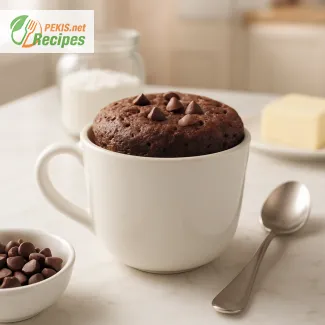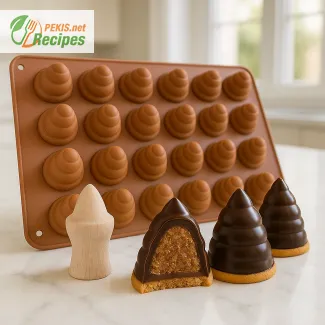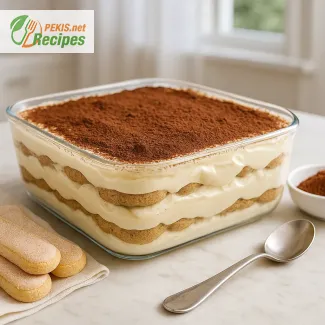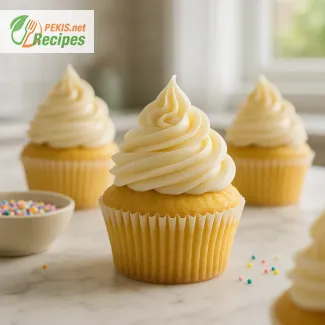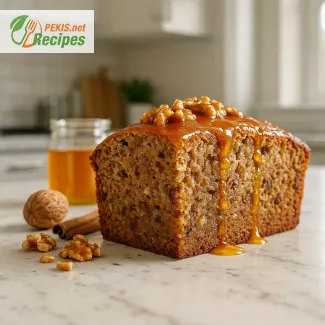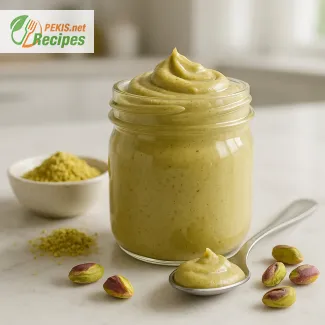
Indulge in the delicate, silky allure of panna cotta, a timeless Italian dessert that marries simplicity with sophistication. The classic panna cotta—Italian for "cooked cream"—is a true testament to the beauty of minimal ingredients. When adorned with the vibrant tartness of fresh raspberries and an exquisite Prosecco sauce, this dessert is elevated to a realm of luxury and elegance, perfect for special occasions or when you simply want to treat yourself to something extraordinary.
Raspberries and Prosecco: A Perfect Pairing
The combination of raspberries and Prosecco introduces a wonderful balance of flavors to the creamy panna cotta base. Raspberries bring a hint of tartness, their natural brightness contrasting perfectly with the creamy, slightly sweet notes of the panna cotta. Meanwhile, Prosecco, with its delicate bubbles and fruity profile, adds a touch of sophistication, infusing the dessert with a hint of effervescence and a subtle, fruity aroma. This pairing turns panna cotta into a multidimensional experience, where each bite is layered with creaminess, acidity, and a hint of sparkling sweetness.
A Creamy Canvas
The panna cotta itself serves as a creamy, blank canvas. Traditionally made with heavy cream, milk, and a touch of vanilla, the panna cotta offers a rich, smooth texture that melts in your mouth. Each spoonful brings a luscious, velvety consistency that pairs beautifully with the fruity sauce. The hint of vanilla adds warmth, making the panna cotta itself a dessert worth savoring on its own. When combined with the raspberry and Prosecco sauce, however, this dessert is elevated to a whole new level, where every bite delivers a perfect harmony of flavors and textures.
The Elegance of Prosecco Sauce
What sets this panna cotta apart is the luxurious Prosecco sauce. Prosecco, a popular Italian sparkling wine, is known for its light, floral, and fruity notes, which perfectly complement the delicate nature of panna cotta. The sauce is reduced to concentrate its flavors, creating a syrupy consistency that coats the panna cotta beautifully. With just a hint of sweetness and a whisper of acidity, the Prosecco sauce brings a sophisticated touch, making this panna cotta an elegant dessert choice for gatherings, romantic dinners, or special celebrations.
A Visual and Sensory Delight
Visually, panna cotta with raspberries and Prosecco sauce is a show-stopper. The pristine, creamy panna cotta provides a lovely contrast to the vivid red raspberries, while the Prosecco sauce adds a translucent, golden sheen that catches the light beautifully. Garnished with a few fresh raspberries and perhaps a sprig of mint, this dessert is as beautiful to look at as it is delicious to eat. The presentation exudes elegance and sophistication, making it an ideal dessert to serve when you want to impress your guests.
Perfect for Any Occasion
Whether you’re hosting a fancy dinner party, celebrating an anniversary, or simply looking to elevate a quiet evening at home, panna cotta with raspberries and Prosecco sauce is a dessert that delivers on every level. It’s not overly sweet, making it a great choice to pair with an after-dinner coffee or a glass of chilled Prosecco. Additionally, its creamy yet light texture leaves you feeling satisfied without being overly indulgent, making it suitable even after a multi-course meal.
An Italian Classic with a Modern Twist
This panna cotta is a modern twist on a classic Italian dessert. By introducing the flavors of raspberries and Prosecco, this dish captures the essence of Italy’s culinary artistry, where tradition meets innovation. The result is a dessert that’s both familiar and exciting, a blend of creamy, fruity, and sparkling flavors that appeals to all the senses. This panna cotta isn’t just a dessert—it’s an experience, a journey to Italy, and a celebration of the finer things in life.
For anyone who appreciates the beauty of elegant, well-balanced desserts, panna cotta with raspberries and Prosecco sauce is a must-try. It’s easy enough to make at home but refined enough to feel like something you’d order at a high-end restaurant. This dessert is a reminder that sometimes, the most luxurious flavors come from the simplest ingredients—when they’re combined with care, creativity, and a touch of sparkle.
1. Prepare the Gelatin
- If using gelatin sheets, place them in a bowl of cold water and let soak for 5 minutes until softened.
- If using powdered gelatin, sprinkle it over 2 tbsp of cold water and let it bloom for about 5 minutes.
2. Heat the Cream and Milk
- In a saucepan, combine the heavy cream, milk, and sugar. Cut the vanilla bean in half, scrape out the seeds, and add both the seeds and pod to the mixture (or simply add vanilla extract if using).
- Heat over medium heat until it starts to steam, but do not let it boil. Stir occasionally until the sugar is fully dissolved.
3. Add Gelatin to Cream Mixture
- Remove the saucepan from the heat and take out the vanilla pod. Squeeze out excess water from the softened gelatin sheets (or use bloomed powdered gelatin) and stir it into the warm cream mixture until completely dissolved.
4. Pour and Set the Panna Cotta
- Divide the mixture into individual molds or serving glasses. Allow it to cool to room temperature, then cover and refrigerate for at least 4 hours (or overnight) to set.
5. Prepare the Raspberry and Prosecco Sauce
- In a small saucepan, combine raspberries, Prosecco, sugar, and lemon juice. Heat over medium heat until raspberries break down and the sauce thickens slightly (about 10 minutes). Remove from heat and strain to remove seeds if a smoother sauce is desired.
- Let the sauce cool before serving.
6. Serving
- Once the panna cotta has set, top each serving with a spoonful of the raspberry-Prosecco sauce and garnish with fresh raspberries if desired.
Creating the perfect Panna Cotta with Raspberries and Prosecco Sauce involves a deep understanding of each element and how slight adjustments can elevate the dessert’s flavor, texture, and presentation. Below are detailed tips and professional advice to influence various aspects of this recipe, focusing on ingredient quality, texture control, flavor balance, dietary adaptations, and presentation.
1. Ingredient Quality – The Foundation of a Superior Dessert
The quality of ingredients directly impacts the richness and sophistication of panna cotta. Choosing premium ingredients enhances both flavor and texture, ensuring a memorable dining experience.
- Cream and Milk: Use fresh, high-fat cream (at least 35% fat content) to create a truly creamy panna cotta. Organic, non-homogenized cream provides an even richer taste. For milk, whole milk is ideal; however, if a slightly lighter version is desired, you may opt for semi-skimmed milk without compromising too much on texture.
- Gelatin: Gelatin is key to the panna cotta’s structure. Choose a high-quality gelatin to avoid an unpleasant aftertaste or rubbery texture. Leaf gelatin tends to produce a more transparent result than powdered gelatin and can offer a smoother consistency.
- Vanilla Bean: Using a fresh vanilla bean instead of extract imparts a more complex flavor. The tiny vanilla seeds not only add flavor but also a visual appeal with small, black flecks throughout the panna cotta.
- Prosecco: Quality Prosecco contributes to the luxurious feel of the sauce. A dry or semi-sweet Prosecco balances the sauce, while a sweeter version can add more pronounced fruitiness. Always choose a Prosecco you enjoy drinking, as it will reflect in the final dish.
2. Texture Control – Achieving the Ideal Consistency
A perfect panna cotta should hold its shape yet have a delicate, creamy texture that melts in the mouth. Achieving this balance requires attention to the setting process.
- Gelatin Ratios: The right amount of gelatin is crucial. Too much will result in a firm, almost rubbery dessert, while too little will prevent it from setting properly. For a slightly softer panna cotta, reduce the gelatin by about 10-20% of the specified amount; for a firmer panna cotta, increase slightly.
- Blooming Gelatin Correctly: When using powdered gelatin, ensure it’s fully bloomed by letting it sit in cold water before heating. This process helps it dissolve completely, avoiding any grainy texture.
- Heating the Cream: Do not bring the cream mixture to a boil, as this may cause it to curdle. Heating it just until it steams ensures a smooth, even texture. Boiling can also destabilize the gelatin, resulting in a less-than-perfect set.
- Setting Time: Allow the panna cotta to set in the refrigerator for at least 4 hours, preferably overnight. Rapid chilling can cause a rubbery texture, while adequate chilling creates a velvety finish.
3. Balancing Flavors – Harmony Between Creaminess and Tartness
Panna cotta is an indulgent dessert, and balancing its rich creaminess with bright, tangy notes enhances its appeal.
- Adding Zest to the Cream: For a subtle citrus lift, consider adding a strip of lemon or orange zest to the cream as it heats. Remove the zest before adding the gelatin to keep the flavor delicate.
- Adjusting Sweetness: For a less sweet panna cotta, reduce the sugar in the cream mixture by 10-15%. Adjust the sugar in the raspberry-Prosecco sauce as well, depending on your taste and the ripeness of the raspberries.
- Layering Flavor with Herbs: Fresh herbs such as basil or mint pair beautifully with raspberries and Prosecco. Infuse the cream with a few basil leaves, or add a sprig of fresh mint to the sauce for an unexpected but delightful herbal note.
- Playing with Acidity: The acidity in the Prosecco sauce balances the panna cotta’s creaminess. Add a small amount of lemon juice to brighten the sauce without overpowering it. A dash of balsamic vinegar can also work well with raspberries, adding a complex, slightly tangy layer to the sauce.
4. Dietary Adaptations – Making It Inclusive
While panna cotta traditionally includes dairy and gelatin, several adjustments allow for a dairy-free, vegan, or vegetarian-friendly version without compromising taste or texture.
- Dairy-Free Version: Replace heavy cream and whole milk with coconut cream and almond milk. Coconut cream provides a rich, creamy texture similar to dairy cream. Almond milk is a neutral base that balances coconut’s distinct flavor, keeping the dessert light and smooth.
- Vegan Gelatin Substitute: Agar-agar, derived from seaweed, is an effective plant-based gelatin substitute. Use half the amount of gelatin specified in the recipe for a similar texture. Note that agar sets at a higher temperature than gelatin, so pour the panna cotta into molds while it’s still warm for an even set.
- Low-Sugar Option: Substitute sugar with a natural sweetener such as honey or maple syrup, but be mindful of the flavor variations. Alternatively, use a sugar substitute like stevia, though you may need to experiment with quantities for the best result.
5. Enhancing Presentation – A Feast for the Eyes
A beautifully presented panna cotta adds to the experience, making it not only a delicious treat but a visually stunning dessert.
- Serving Vessels: Choose transparent glassware or molds to showcase the contrast between the panna cotta’s creamy white base and the vibrant raspberry-Prosecco sauce. Alternatively, silicone molds allow you to unmold the panna cotta for a classic plated look.
- Sauce Application: Drizzle the sauce lightly over the panna cotta, allowing it to pool slightly at the edges. This approach gives a more artistic, refined appearance compared to pouring it fully over the top.
- Garnishing Tips: Fresh raspberries, edible flowers, or a sprig of mint add elegance and color. For a sophisticated twist, garnish with a few gold leaf flecks or edible pearls.
- Chilling Glasses: If serving panna cotta in glassware, chill the glasses before adding the mixture. This technique speeds up the setting process slightly and creates a more visually appealing presentation with no streaks on the glass.
6. Crafting Flavor Profiles with Seasonal Variations
Adapt panna cotta to seasonal flavors by experimenting with different fruits and complementary sauces.
- Summer Variations: Swap raspberries with strawberries, blackberries, or cherries for a summery twist. Infuse the cream with a touch of basil or lavender for a fresh, herbal note.
- Autumn and Winter Variations: In cooler months, try a spiced panna cotta. Add a pinch of cinnamon, nutmeg, or cardamom to the cream. Replace the raspberry-Prosecco sauce with a cranberry or mulled wine reduction for a festive touch.
- Citrus Season: For a refreshing alternative, make a blood orange sauce instead of raspberry. The slight bitterness pairs excellently with the panna cotta’s creaminess, while the color offers a bold, eye-catching presentation.
7. Flavor Pairings – Customizing for a Unique Experience
Personalizing panna cotta with unique flavors and pairings adds depth to its profile.
- Tea-Infused Cream: Infuse the cream with green tea, jasmine, or chamomile for a subtle, floral aroma that pairs well with the fruity sauce. Simply steep a tea bag in the heated cream and milk mixture, then proceed as directed.
- Alcohol-Infused Options: Prosecco provides a sparkling touch, but other spirits can enhance flavors. Replace with a splash of Champagne for a richer wine profile or Cointreau for a hint of orange liqueur.
- Chocolate Drizzle: For chocolate lovers, add a thin drizzle of dark chocolate on top of the panna cotta before the sauce. The bitterness of dark chocolate contrasts nicely with the cream and raspberries.
8. Storage and Make-Ahead Tips
Panna cotta can be prepared in advance, making it an ideal dessert for dinner parties or gatherings.
- Storing in the Refrigerator: Cover the panna cotta with plastic wrap to prevent it from absorbing any fridge odors. It will keep well for up to 2-3 days, maintaining its freshness and texture.
- Making the Sauce in Advance: Prepare the raspberry-Prosecco sauce a day ahead and store it in a covered container in the fridge. Gently reheat before serving if desired, or serve it cold for a refreshing contrast to the panna cotta.
- Serving at the Right Temperature: Panna cotta is best served chilled but not too cold. Remove from the fridge about 10 minutes before serving to bring out the flavors.
In sum, panna cotta with raspberries and Prosecco sauce offers versatility and refinement. With thoughtful adjustments and quality ingredients, you can craft a dessert that is not only delicious but visually captivating and adaptable to various dietary needs. These techniques ensure your panna cotta is balanced, creamy, and memorable—a dessert that feels like a luxurious experience with every spoonful.
- Dairy: Contains cream and milk (can be replaced with coconut milk for a dairy-free option).
- Gelatin: Contains animal-derived gelatin (use agar-agar for a vegetarian option).
- Alcohol: Prosecco contains alcohol, which can be substituted with non-alcoholic sparkling water for a family-friendly version.
Substitution Tips
- Dairy-Free: Substitute heavy cream and milk with coconut milk and coconut cream.
- Gluten-Free: Naturally gluten-free.
- Vegetarian/Vegan: Substitute gelatin with agar-agar. Adjust quantities as agar-agar is more potent.
- Vitamin C: 12 mg - Boosts immune health and skin elasticity.
- Calcium: 60 mg - Essential for bone health and muscle function.
- Potassium: 100 mg - Supports heart health and regulates fluid balance.
- Magnesium: 10 mg - Important for muscle and nerve function.
Raspberries contain ellagic acid and anthocyanins:
- Ellagic Acid: Protects against cellular damage and may reduce cancer risk.
- Anthocyanins: Improve cognitive function and support heart health.
